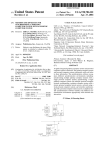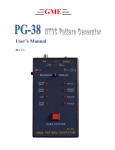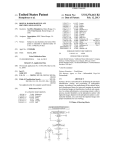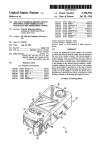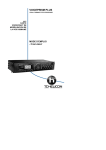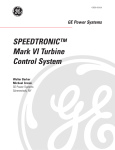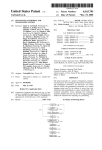Download System for storing and managing plural logical volumes in each of
Transcript
1|l||lllllllllIllllllllllllllllllllllllllllllllllllllllllllllllllllllllllll USO05546557A United States Patent 119] [11] Patent Number: Allen et al. [45] Date of Patent: [54] INCLUDING AUTOMATICALLY CREATING “MS-DOS operating system”, pp. 149-160, 1991. “Introduction to IBM Direct Access Storage Device.” 1990, LOGICAL VOLUNIES IN PERIPHERAL DATA STORAGE SUBSYSTEM “Dictionary of Computing”, 1987, pp. 276, 462-464. [75] Inventors: Vincent K. Allen; Robert S. “Isol IEC 10288” pp. 194-204. A an of Tucson Ariz- . E aminer_Thomas C Lee W x . ' sszstant Exammer-Moustafa Mohamed Meky ’ _ I Attorney, Agent, or F1rm—M. W. Schecter; D. A. Shrfnn; H. Assignee: International Business Machines F‘ somermeyer COI‘POl‘??OIl, Armonk, N.Y. [57] NO; 75,936 [21] AppL _ Jun- 14, 1993 [22] Fllcdi 6 [51] 31 """"""""""""" [52] ‘ ' ‘ 47 3_ 364/248 1_ £64048 2f ’ pp. 5-8 to 5-9. Prima Goncharsky; Richard A. Ripberger, ' ’ ' ’ 364ml _ 1’ ' ABSTRACT peripheral data storage subsystem has means for respond mg to a MOUNT command received from a host processor to create and mount a host-processor-addressable logical data-storage volume. Such logical data~storage volume has a serial number VOLSER indicated in the MOUNT com mand. The logical data volume is assigned a predetermined area of a physical data volume, such area being termed a partition. The illustrated embodiment shows a tape sub Fleld of Search ................................... .. 395/275, 425, System in which the partitions are accessed by a control 395/600’ 6501 438’ 404’ 823; 369/34 R f C, d using a reel tachometer that identifies segments of the tape. Each partition has a number of the tape segments. Controls 8 erences M and methods are described for initializing the subsystem for U‘S_ PATENT DOCUMENTS eifecting the automatic volume creation, appending data into _ a logical volume, how logical volumes are made to be Slit-on at , Aug. 13, 1996 OTHER PUBLICATIONS SYSTEM FOR STORING AND MANAGING PLURAL LOGICAL VOLUMES IN EACH OF SEVERAL PHYSICAL VOLUMES [58] 5,546,557 , 1 ------------------------ " 33695;]620g igane . . 4,430,727 2/1984 Moore et a1. ......... . 4,837,680 6/1989 Crockett et a1. 4,989,191 1/1991 5,013,060 5,129,088 5/1991 Gelb er a1_ __ 7/1992 Auslander ____ __ Kuo . . . . . . . . . . . . . . . . 395/442 395/284 . . . . .. 369/33 395/600 395/700 5,163,134 11/1992 Kakuse et al. .. Hammg BI 81- - - - - - 395/823 5,197,055 3/1993 5,210,866 5/1993 Millig?n 91 a1 5,239,650 8/1993 5,283,875 5,287,500 5,327,535 2/1994 Gibson et al 395/404 2/1994 Stoppani,Jr. .. 395/600 7/1994 Oguta et al. .......................... .. 395/440 Hartung et a1 . ... . - - Emma’ tapelfognzztse lusalbfl forlsuch mg?“ Pumas’ ‘Siam a” “intro 0 ‘Tgw "0 “me? a“ ."0 “me “ea °n 1x09655199 The PhYSIC‘TJ volume 1“ whlch one or more log1cal volumes reside is not host-processor addressable. Some physical volumes are ejectable from the data storage subsystem. The physical volumes storing the logical vol - - - - - t - - -- 369/34 urnes are not ejectable. To eject a logical volume, it is copied 395/ 182-04 from the storing physical volume to an ejectable physical . . . . . . .. 395/650 volume‘ 65 Claims, 11 Drawing Sheets 15 16 17 / / / MANUALLY DEFINE A DATA STORAGE VOLUME portable, moving logical volumes amongst diverse physical AUTOMATICALLY REQUEST MOUNT OF DEFlNED DATA STORAGE VOLUME AUTOMATICALLY ESTABLISH DEFINED DATA STORAGE VOLUME 18 / AUTOMATICALLY ALLOCATE DATA STORAGE SPACE IN A VOLUME AND STORE DATA US. Patent Aug. 13, 1996 Sheet 1 of 11 FIG. 1 PRIOR ART 10 12 / MANUALLY DEFINE 1S / MANUALLY ACTUATE A DATA STORAGE SYSTEM TO VOLUME ESTABLISH VOLUME / AUTOMATICALLY ALLOCATE DATA ' STORAGE SPACE IN A VOLUME AND STORE DATA Fl G. 2 15 16 11 / / / MANUALLY DEFINE A DATA STORAGE VOLUME AUTOMATICALLY REQUEST MOUNT OF DEFINED DATA STORAGE VOLUME AUTOMATICALLY ESTABLISH DEFINED DATA STORAGE VOLUME 18 I / AUTOMATICALLY ALLOCATE DATA STORAGE SPACE IN A VOLUME AND STORE DATA US. Patent Aug. 13, 1996 Sheet 2 of 11 5,546,557 PRIOR ART 20 21 22 / x / FID 24 / DATA STORED IN BLOCKS / / I BOV / (23 I LBOV LEOV / k PEOV BOV - BEGINNING OF VOLUME LBOV - LOGICAL BEGINNING OF VOLUME LEOV - LOGICAL END OF VOLUME PEOV - PHYSICAL END OF VOLUME FID - FORMAT IDENTIFICATION BLOCK HUB 32 33 / I / I] 33A / I I FID (\ 34 35 / II / I | FID VOLIUME | l 1 I ( I \ [I FID / I\ \ BOPLBOP \EOD \BOPKEOD BOP) PEOP EOD 36 / I / 38 I l \I I VOLUME FID VOLUME a [I \\ 3g / I END \) x I I I | | \ 37 EDD 31 PEOP BOP FREE OR LEADER END LEOP BOP - BEGINNING OF PARTITION LBOP - LOGICAL BOP EOP LEOP END OF PARTITION LOGICAL EOP US. Patent Aug. 13, 1996 Sheet 3 of 11 5,546,557 / ,30 i _________ _ "3T1'> ___________ ' '3},'''''' " '1 l PRV\ :(a l \ \ :/—-~ / l | 315 I :& IL s30 \<- \ 5 330 \-~ \s15 V 312 A 330 \\ -~ 321 PVP PORTION OF DATA BASE s3 ~ l w 330 \\ -~ 320 65 / ~ \ k \a1a FIG. 7 PERIPHERAL DATA BASE \ \ vouo LV INDEX CATEGORY DATE/TIME MOUNTED AFFINITY TYPE LIB HISTORY £832; LAST USE LV PORTION OF DATA BASE JOB ,0 66 74 \ / 73 72 \ \ VOLSER VOLID OU START PRV STOP PRV PARTITION N0. MOUNT MREQNT HISTORY JOBID DATE/TIME : l ea s7 'I'l ——318 7?:l 313_\_ N316 _ V sso ‘ CAT POINTERS : : U.S. Patent Aug. 13, 1996 Sheet 4 0f 11 5,546,557 FIG. 6 45 w UME mw“ML VH 00 Mamm % m m M H/ HOST PROCESSOR MOUNT VOLSER(S) DRIVE CATEGORY 48 V R was L WALHWGM WOTnluE PWLMO 5WACF WEE.CATD8 OAC U0ESE8OP “CGLS(E 0OnTROn M“RL A M U m/ EIUG PRE .WTQ PmPOL F HY L U M W YB WAD7\P OVOVU_EASU MUT“WORPGLm_MmMTh RV_CPV PMH_VWVWMP.YPLR M EN A_ E _ E .. pmmpv. W\_ AW KW\WM m,HVM _ M NAT GEDS (BEmW L _DTORVS C DEOM_EMED .N 0 W MC _ D_Iw_ %1/0 - VOLUME ID EXTERNAL VOLSER - VOLUME SERIAL NUMBER INTERNAL US. Patent Aug. 13, 1996 Sheet 5 0f 11 5,546,557 92 \ MANUALLY SELECT PHYSICAL VOLUMES THAT ARE TO BE PARTITIONED PVP‘S AND PVO'S 93 FIG. 8 MANUALLY SPECIFY RANGE OF SIZES FOR LOGICAL OR VIRTUAL VOLUMES TO BE STORED IN THE SELECTED PHYSICAL VOLUMES 94 \ I MANUALLY IDENTIFY A RANGE OF VOLSER'S FOR LOGICAL VOLUMES 95 \ 96 / MANUALLY DEFINE HEADER FIELDS OF LOGICAL VOLUMES _ STANDARD LABEL ASSIGN ALL PVP'S AND LV'S TO THE INSERT CATEGORY 1 00 NO 101 \ YES 103 / SET STACK CATEGORY FOR PVP IDENTIFY PVP'S & PVO'S I 102 \ v EXIT l US. Patent Aug. 13, 1996 110 Sheet 6 of 11 5,546,557 PHYSICAL ONLY \ o - (10K - 1) PvC 111 \ we PARTITICNED VOLUMES F161. 9 10K- (100K- 1) VOLUME RANGE “a 150 \ LV‘S 100K+ 152 . \ ASSIGN To SCRATCH VCLSERISI 15a \ PRICRITY 155 156 157 158 \ \ \ \ DEvICE voLSER(S) TARGET ADDRESS VOLID(S) LCCATI0N(S) 160 161 163 164 165 \ \ \ \ \ LCCATE DEvICE ADDRESS M'GRATE C P BLOCK NUMBER PARTITION NUMBER PHYSICAL REFERENCE VALUE CTRER PARAMETERS \ \ 110 172 CHANGE DEvICE REE/3mg’; oTHER SEGMENT ADDRESS VALUE FIELDS \ \ \ \ 180 181 182 171 U.S. Patent Aug. 13, 1996 5,546,557 Sheet 7 of 11 120 \ REQUEST HOST PROCESSOR TO CREATE DATA STORAGE SPACE FOR A DATA SET 121 FIG. 10 \ AUTOMATIC CLASS SELECTION 122 127 \ / HOST PROCESSOR ISSUES MOUNT COMMAND VOLSER EXIST? YES - SELECT PVP STORING LV 123 NOT EXISTI FIND PVOL THAT CAN CONTAIN LV, THEN CREATE LV \ PVM SEARCHES FOR VOLSER IF NO VOLSER, SELECT PVOL FOR CREATING AN LV PVP SELECTION CRITERIA CATEGORY FILTER AFFINITY FILTER EXPIRATION DATE MOST FREE SPACE CURRENTLY MOUNTED MOUNT PVP TO DRIVE ' 141 / 131 \ POSITION TAPE TO PRV FIND EMPTY PARTITION FOR THE LV SELECT PVP FROM THE STACK CATEGORY 146 / / 132 RECORD FID 133 \ HOST PROCESSOR COMMANDS REWIND AND UNLOAD 134 \ PVM UPDATES DB AND STORES PVOL 147 / RECORD FID 32 RECORD PH 33 (HDR1) US. Patent Aug. 13, 1996 5,546,557 Sheet 8 of 11 PVP - PHYSICAL VOLUME - PARTITIONED PVO - PHYSICAL VOLUME - ONLY MIGRATE FIG. 1 2 SELECT MIGRATION PHQCESSMG PVP TO LIBRARY LV’S 202 \ 21 s / I PRIOR ART MIGRATION SELECT TwO DEVICES 2/03 21\6 ~ MOVE PVP TO IO STATION LOAD Two PVP’S I 217 \ ' 204 / MOVE LV'S 2&8 DONE MOVE PVP TO STORAGE CUBICLE NO YES 209 2 \ UPDATE DATA BASE IMO I US. Patent Aug. 13, 1996 Sheet 9 of 11 5,546,557 LOCATING BLOCKS IN LV’S READ BLOCK ID 225 LOCATE BLOCK ID 230 \ BLOCK ID COMMAND IS ISSUED TO FIND LOGICAL BLOCK AFTER WHICH DATA BLOCKS RECEIVE LOCATE BLOCK ID COMMAND HAvING THE FIRsT STARTING PRv wILL BE ADDED 231 \ 226 \ PVM READs THE sTART PRv FROM FIELD as IN THE DATA BAsE ‘ SUBSYSTEM RETuRNs TO HOST PROCEssOR THE PHYSICAL REFERENCE INDEX AND THE 23\3 NUMBER OF THE LOGICAL BLOCK PVM CHANGEs THE RECEIVED sTART PM TO THE DATA BAsE PRv 227 \ ' HOsT PROCEssOR sAvEs THE PARAMETER 'NFORMAT'ON FOR LATER FINDING DATA BLOCKS TO BE APPENDED ON TAPE AFTER THE IDENTIFIED LOGICAL BLOCK 234 \ PSC CALCuLATEs THE SEGMENT SIZE BAsED ON DIRECTION BIT. ADJUSTED SEGMENT NUMBER FOR CONTROLLING HIGH SPEED sEARCH 235 \ LOCATE BLOCK ID COMMAND Is EXECUTED AS A HIGH SPEED SEARCH US. Patent 240 Aug. 13, 1996 Sheet 10 of 11 5,546,557 FI G. 1 4 \ PVM DETECTS ACCESS REQUESTS TO TwO LV'S IN ONE PVP FIG 1 6 241 ' \ 260 \ SEND NOT READY SIGNAL To HOST PVM DETECTS ACCESS 242 \ REQUEST CONFLICT TO MULTIPLE LV'S W A FIRST pvp SELECT A TARGET PVP HAVING THE SAME CATEGORY AS SECOND REQUESTED LV(S) 24s 2 I MOUNT TARGET PVP(S) 63 \ SEND UNIT CHECK TO FIRST REQUESTING HOST 247 \ SEND LONG BUSY TO ‘ 264 THE ORIGINAL HOST \ 244 - \ I IN HOST PROCESSOR WAIT COPY SECOND LV(S) ABORT CURRENT JOB FROM FIRST PVP TO RESPECTIVE MOUNTED ABORT NEw JOB TARGET PVP(S) 245 \ ‘ EXIT UPDATE DATA BASE 246 \ I SEND MOUNT COMPLETED RESPONSE TO SECOND REQUESTING I-IOST PROCESSOR 248 \ SEND No LONGER BUSY TO ORIGINAL REQUESTING HOST PROCESSOR US. Patent Aug. 13, 1996 Sheet 11 of 11 5,546,557 FIG. ‘I8 300 FIG. 17 305 APPEND DATA 280 WRITING DATA IN AN LV 306 301 307 SEND uc TO WRITING HOST 283 END OF FILE (EOF) 284 / P801 251 P802 / FIG. ‘I5 252 /253 DVE 5,546,557 1 2 SYSTEM FOR STORING AND MANAGING PLURAL LOGICAL VOLUMES IN EACH OF SEVERAL PHYSICAL VOLUMES INCLUDING AUTOMATICALLY CREATING LOGICAL VOLUMES IN PERIPHERAL DATA STORAGE SUBSYSTEM storage, the VOLID is repeated internally in the physical volume as a machine-readable copy of the VOLID. Each LV has an internally stored VOLSER that identi?es it as a data LA DOCUMENTS INCORPORATED BY REFERENCE storage volume. A logical volume is a data storage volume that is addres sable by a host processor independently of which physical volume is storing it. The volume identi?er VOLSER of each logical volume is independent of the physical volume iden ti?er VOLID and is usually not externally available on the physical volume. Clifton et al US. Pat. No. 4,310,883 is incorporated for its showing of a host processor allocating data storage space in A physical volume - - - partitioned (PVP) is a physical a virtual volume selected from a group of such virtual volume that is divided into a plurality of physically-identi (logical) volumes. ?able partitions, each partition is logically co-extensive with Gelb et a1 U.S. Pat. No. 5,018,060 is incorporated for its showing of a host processor using automatic storage class selections for enabling enhanced data storage volume selec tion in allocating data storage space in a data storage volume a single logical volume. That is, one partition has one logical partition. The medium physical locations in the physical cal reference values (PRV’s) useful for rapidly accessing cal only or PVO. volume that may or may not completely occupy the one volume are addressable by means external to the physical volume as addressable segments. Each partition/logical vol for a data set. ume consists of an integral number of contiguous segments. 20 Milligan et al US. Pat. No. 4,393,445 is incorporated by Partitions may be of ?xed length or variable length. An reference for its showing of a peripheral data-storing tape unpartitioned volume is a physical volume that has one subsystem in which the subsystem generates and uses physi partition. Such a physical volume is termed as being physi— blocks of data stored in any one of a plurality of magnetic tapes. 25 A partition is a portion of a physical volume that is machine-identi?able either by machine-sensible marks on a Co-pending commonly-assigned application for patent by medium constituting the physical volume or by machine sensible positions (with or without marks on the medium) of Kulakowski et al Ser. No. 07/816,590, ?led Jan. 3, 1992, now US. Pat. No. 5,303,214 is incorporated by reference for its teaching of a?ine groups of data sets and data storage volumes, logical or physical, in a multi-media automatic such medium. For sensing machine-sensible positions of a tape physical volume, as shown in Milligan et al, supra, a media library data-storing subsystem. volume measures tape displacement of the tape in the tape tachometer of a tape drive that mounts a tape physical FIELD OF THE INVENTION This invention relates to peripheral data storage sub 35 system, more particularly to such subsystems that can auto volume past a transducer for enabling machine sensing the current portion of the tape being scanned by the transducer in the tape drive. For interchange of each tape physical volume between diverse tape drives, appropriate tape-mo tion tolerances are accommodated in de?ning partitions of each tape. A partition is not directly nor explicitly address able by the host processor in a PVP, only the LV is addressable. matically create data~storing logical or virtual volumes and the management of such volumes without any or a minimal host processor intervention. GLOSSARY AND DEFINITIONS OF TERMS The following terms are used in this document: A data storage volume or volume is a unit of a data storage medium that is separately addressable and is identi?ed by a volume identi?er. As used below, only for the purpose of consistency in terminology, the volume identi?er for a GLOSSARY of ACRONYMS ACL 45 logical volume is termed VOLSER while the volume iden ti?er for a physical volume is termed VOLID. In the prior art VOLSER and VOLID have been used interchangeably. To c?’ect access to data storing locations in a volume, a host processor requests that an addressed volume be mounted in an addressed device for accessing data storage space of such Automatic Class Selection ATL Automatic Tape Library CAR Category or CAT FID Concurrent or con?icting Access Requests Code assigned to a PV, VV or LV de?ning an attribute of the respective volume Format Identi?cation FSID Format Segment Identi?cation HDRl Contains the VOLSER the LV, in a STACK category PVP or an empty LV, I-IDRI contains a speci?c code indicating that the volume contains no data. I/O _ volume. LBOP A physical volume is a volume that is always a physical 55 LBOT LBOV package, such as a tape cassette or cartridge, a disk cartridge, LEOP and the like. Each physical volume is independently mount LV able into a device to provide access by a host processor to its data storage space. In the prior art, such physical volumes are directly addressable by the host processor. In practicing this invention, a plurality of logical volumes (LV) are located in, but transportable from, a physical volume. To access data storage space in a physical volume having LVs, only the LVs are addressed by a host processor. This physical volume is not separately directly addressable by a host processor. The volume identi?er VOLID on a physical volume is readable by a human being. In the prior art data Automatic Cartridge Library ACS PBOP PBOT PEOP PEOT PRV Input-Output Logical Beginning of Partition Logical Beginning of Tape Logical Beginning of a Volume (PV, VV or LV) Logical End of Partition Logical Volume Physical Beginning of Partition Physical Beginning of Tape Physical End of Partition Physical End of Tape Physical Reference Value of a tape physical volume, used to identify locations of LV’s in a PVP. This quantity is also term a Physical Reference Index (PR1). 65 PVO PVP Physical Volume -- Only (one addressable volume as in the prior art. Physical Volume -- Partitioned into logical 5,546,557 3 4 -continued The volume image is no longer externally identi?able such that some component of the host/library system must maintain a mapping of logical volumes to physi GLOSSARY of ACRONYMS cal volumes. This mapping information is a critical volumes LV Segment The physical portion of a tape that is system assist which must be highly available, highly reliable, and disaster recoverable. Logical volumes in a same mounted physical data storage addressable by a tachometer on a tape drive spool Segment No. The PRV value that enables addressing a SEGNO logical volume by segment Segment number (see Segment No.) VOLl Contains the VOLID for the PV VOLID VOLSER Physical Volume Identi?cation Volume Identi?cation (serial number) for volume are not concurrently accessible. When there are requests to simultaneously mount a plurality of logical volumes stored in a same physical volume, either all but one of the mounts must be deferred, possibly creating a data processing deadlock. An alternative is to move all but one of the logical volumes from the one a virtual or logical volume physical volume to other physical volumes. If a data movement solution is chosen, access to any data on the BACKGROUND OF THE INVENTION The average size of data sets in most computer or data processing centers is signi?cantly less than the capacity of tape or optical data-storing disk volumes. Also, most pro 20 one physical volume is delayed while the copies are made. This solution may not always be practical for many data processing environments. Access to the ?rst byte of data stored in a physical tape volume may be slower than if but one logical volume gramming support for peripheral data storage subsystems is stored in each physical tape volume. That is, since the does not provide a general solution to storing multiple data beginning of any logical volume is usually displaced sets in the same volume, particularly tape volumes. Conse from the normal loading point, the tape has be to moved to position the beginning of a logical volume at the tape quently, the potential capacity of tape storage is often not realized because a single small data set is stored in one tape 25 volume leaving the remainder of the volume unused. With the advent of automated tape libraries (ATL), the cost of this unused storage includes, not only the percentage of the volume which is not utilized, but also the cost of storing that unused medium in the ATL. Tape products and their associated software support which develop mecha nisms which can fully utilize volume capacities will, in general, have a signi?cant competitive advantage over com parable products which cannot fully utilize volume capacity. One possible mechanism to better utilize the capacity of a tape volume is to store multiple volume images, virtual or logical volumes (LV), on a single physical volume. For better utilization of data—storage space, the data which would drive transducer or head. Depending on how data storage space is managed for logical volumes (each addressable logical volume is stored in a “partition” in a physical volume), the size 30 (number of data bytes) of a logical volume (data storage space required for a logical volume must accommodate volume size) can be expected to be unpredictable. One solution is to prevent appending 35 data to data currently stored in a logical volume that is “?rll”. Such partitions as used herein, are logically co-extensive with logical volumes. High speed searches on the tape are based on segments or position reference values (PRVs), as will become apparent and as set forth in Milligan et al, supra. Some prior art have been stored in multiple, mostly unused, physical vol documents use the term “partition” in a same vein as the term “segment” is used herein. umes are collected into a single physical volume. Such data, in accordance with this invention, are stored in separately To solve the above-‘stated problems, as well as other addressable host-processor de?ned logical data storage vol problems, using current day data storage management prac umes. Access to the ?rst byte of data in such logical or tices requires an undue attention to assignment and storage virtual volumes may be slower than the access to a ?rst byte 45 of data using the logical volume approach. It is desired that of data in a single physical volume. In the logical volume the current practices in host processors and manual proce case the beginning of the logical volume is generally some where away from the normal tape loading point. This fact dures required by attending personnel not be made cumber means that before the ?rst byte of data in a logical volume methods for storing a plurality of logical data storage volumes in one physical data storage volume wherein the is accessible, not only is the physical volume mounted but the logical volume has to be found by moving the tape to place the logical volume at the tape transducer. Also, con current con?icting access requests to multiple logical vol some. Therefore, it is desired to provide mechanisms and 50 attending personnel do not change for de?ning volumes. It is desired to eliminate the current need for de?ning and umes residing on the same tape have to be resolved. It is also desired that the host processor and/or personnel operating the host processor have no activities that relate to storing a plurality of volumes of data in one physical volume. In the prior art, manual control is required for creating or establishing a de?ned or requested data storage volume. It is desired to limit the required manual steps to data management activates in a host processor and of the 55 assigning which physical data storage volume is to be used for storing any given logical volume and to eliminate a current need for assigning a physical volume for storing data before that data are sent to a data storage system. In other words, the management of data storage volumes is trans parent (not seen) by either the host processor nor its attend 60 ing personnel. merely de?ning each desired volume and for inserting scratch physical volumes into an ATL or open shelf storage. The bene?ts of this enhanced capacity utilization without DISCUSSION OF THE PRIOR ART host processor nor personnel involvement greatly simpli?es and obviates the need for personal attention to a data storage system. However, these bene?ts come at the expense of creating additional problems which must be handled, that is: Clifton et al in US Pat. No. 4,310,883 describe a mass 65 storage system wherein one disk volume (IBM 3330 disk volume) was emulated by two tape cartridges in an auto matic cartridge library (ACL). The disk volumes are termed 5,546,557 5 6 “virtual volumes” even though the system is a one-for-one establish each and every such logical volume or disk. That is, no automatic means have been shown for automatically creating or establishing a logical volume LV or logical disk. emulation of two tape cartridges for each disk volume. Clifton et a1 host processor automated emulated disk volume selection using a best ?t detector. All emulated disk volumes were established by manual actuation of the system before the Clifton et al automated volume selection could be invoked. The emulated disk volumes are grouped into so called volume groups. Clifton et a1 grouped virtual volumes The DICTIONARY OF COMPUTING, IBM, Eight Edi tion, 1987, pp 276 and 462-464 de?ne some of the terms listed above. The term “minidisk” on page 276 includes the synonym of “virtual disk”. The term “virtual disk” is de?ned on page 462 as being either a so~called RAM disk (in main storage) or a “logical subdivision of, a physical disk storage device that has its own address, consecutive storage space for data, and an index or description of stored data so that the data can be accessed.” Again, each and every one of such “virtual disks” are individually established via a separate into “volume groups” by user (manual selection, input to the primary host processor) chosen criteria. Such criteria are application area, common retention period and space allo cation quantities. One volume group could not be subordi~ natcd to another volume group. A best ?t volume selection criterion included several volume attributes, such as volume manual actuation of the data processing system. An example of manually actuating a data processing expiration date being later than a data set expiration date, available free space and the like. Once each data set is assigned to a given emulated disk volume, allocation and storage activities ensued. Gelb et al in U.S. Pat. No. 5,0l8,060 extended the automation of volume selection started by Clifton et al. Gelb ct 31 provide for inferred or implicit automatic volume selection based upon three data/volume de?ning class system for establishing a virtual disk or a minidisk is set forth in the Microsoft MS-DOS User’s Guide and Refer ence, Version 5.0, 1991, in pages l49—160. These pages describe a DOS utility program FDISK provides an operator 20 interface for establishing “virtual disks”. That is, one physi cal disk is divided into a manually indicated number of “partitions”, each partition being addressable as a separate attributes. A DATA class includes user de?ned data virtual disk. The program is usually used for disks that are attributes. A STORAGE class de?ned user inputted perfor mance and other storage related parameters, viz capacity, not removable. access time etc. A user de?ned MANAGEMENT class 25 related to scratching volumes and data sets and the like. The Milligan et al in U.S. Pat. No. 4,393,445 show generating a physical reference value (PRV) based upon tape displace ment past a transducer. Such PRV’s are not separately three classes are used to select a volume identi?ed in one or indicated on the tape. Rather, spool rotation is used to measure tape displacement for identifying the PRV numbers. According to Milligan et al, such PRV numbers are usable by a host processing to quickly move to a desired tape more STORAGE groups of volumes. A primary purpose of Gelb et al apparently is to automatically assign data sets to data storage volumes based on established criteria (classes) that use inferences or hints identifying the data set to select a data storage volume. Gelb et al, like Clifton et al, use displacement position (locate recorded data blocks) or for error recovery purposes. Milligan et al also teach that a PRV is usable for indicating status of a data buffer that stores data 35 to be either written to or has been read from a magnetic tape. The IBM Technical DisclosureBulletin, Vol 35, No. 5 Such PRV values respectively denote reference points on a October 1992, pp 17-20, describes improving data-storage magnetic tape that are generated and indicated by means not volume management by using categories. A category is on the tape, i.e. there are no marks showing such PRV’s on de?ned for including data-storage volumes having a com the tape. The present invention uses the PRVs to indicate mon attribute. Such common attributes include scratch vol 40 media segments. One or more segments are combined into umes, expiration dates, common user, type of volume, a logical volume that is said to occupy one “partition” on the host-processor data related to a job or a set of Jobs, volumes storage medium, i.e. one partition as that term is used to to be transferrer or migrated to a scratch category, and the “partition” hard disks used with DOS and 08/2 operating already established volumes based on manual actuation of the system to recognize such physical or emulated volumes. like. A mount by category is indicated as mounting any volume that is a member of a category. One example is systems. A proposed Small Computer Standard Interface (SCSI) mounting one volume from a scratch category. standard, ANSI document ISO/IEC 10288 - ~ - ANSI Co-pending commonly-assigned application Kulakowski X3.131:l992R, Nov. 16, 1992, in pages 190—204 describes partitions on a magnetic tape. Such partitions are compa et al Ser. No. 07/816,590, ?led Jan. 3, 1992, now U.S. Pat. No. 5,303,214 shows an automatic media library subsystem that uses an aflinity characteristic for managing data-storage volumes. That is, those data-storage volumes storing data that have a predetermined functional relationship (host pro rable to “segments” described herein, i.e. physical portions 50 of the tape that are addressable by means external to the tape (enable the tape to be transported in a high speed positioning operation without contact with the tape). Such high speed positioning, as taught by Milligan et al, supra, is preferably cessor determined) have an affinity. Af?nity classes are established. Cartridges that are members of a same a?inity a tachometer on a reel mount in a tape drive. Section 10.1.3 class must be entered and exited from me library as a unit. 55 (page 192) of the ANSI document describes a proposed The storage location of the cartridges having such an af?nity standard for “partitions within a volume”. Partitions, sic is preferably in close physical association in the library segments, consist of one or more non-overlapped tape areas. storage compartments. It is desired to extend the Kula Each partition (segment) has its own beginning and ending points. In each magnetic tape volume (one reel of tape), every partition has a de?ned beginning-of~partition (BOP x), an early-warning position (EW x) and an end-of-partition (EOP x), where x is the partition number. The partition kowski et al allinity control for better managing logical volumes having such an a?inity for enhancing accessing the 60 various logical volumes depending on the nature of the a?inity. The terms “virtual volume” and “logical volume” have been used to denote identifying a portion of a storage medium as an addressable entity. Also, the term “minidisk” has been used to mean “virtual disk”. All of this usage has required a manual actuation of the data processing system to (segment) numbers need not be recorded on the medium. Milligan et al do not mention the early-warning or end-of 65 partition format blocks. For interchange, information about which partitions (segments) are present in a magnetic tape volume may be stored in the volume in a device-de?ned area 5,546,557 7 8 or such information may be an intrinsic attribute of device ume usage or LV usage. Diverse media, such as magnetic implementation. What such information consists of is not de?ned in the SCSI document. That is, the standard does not tape, optical tape, magnetic disks or optical disks may be employed, alone or in a mixed media library. address how such partitioning could or should be accom The foregoing and other objects, features and advantages plished. The SCSI document does indicate that tape move ment between partitions (segments) has no stable position, i.e. exact position is not known as the tape transducer and of the invention will be apparent from the following more particular description of preferred embodiments of the invention, as illustrated in the accompanying drawings. tape are not in contact. According to the SCSI document, each partition (seg ment) has logical elements that include host processor (initiator) elements of data and ?le marks, i.e. usual tape formatting. Each unit of data is stored as a logical block. Logical block storage is in accordance with the format being used in the volume (entire tape, not in logical volumes on the tape). A “setmark” is de?ned that is a mark superior to ?le marks, i.e. there may be a plurality of ?le marks disposed between a pair of spaced-apart setmarks in any partition (segment). The SCSI document does not describe how such partitioning (segmentation) is to be accomplished nor how to manage a subsystem using such partitioning. See Milligan et al, supra. DESCRIPTION OF THE DRAWING FIG. 1 illustrates known prior art volume creation/estab lishment methods. FIG. 2 illustrates a method for the creation/establishment of data storing volumes in accordance with the present invention. 20 of a logical volume in the FIG. 4 illustrated tape format and the use of physical references for locating and identifying multiple logical volumes on a tape including logical vol SUMMARY OF THE INVENTION The present invention being practiced in a data processing system having a peripheral data storage subsystem causes FIG. 3 illustrates a prior art magnetic tape format. FIG. 4 illustrates, in simpli?ed form, a multi~volume tape format constructed in accordance with the present invention. FIG. 5 illustrates, in simpli?ed form, the logical elements umes in a magnetic tape have a so-called serpentine track 25 the subsystem to respond to a MOUNT command received from an attached host processor when no volume exists to be mounted to create or establish a volume, then mount the volume for responding to the MOUNT command. Such 30 volumes can be logical or virtual volumes established in a physical volume, i.e. such as a reel of tape. The subsystems manages the logical volumes (LV’s) in relation to the physical volumes using a peripheral data base. Each physi— cal volume can contain a variable number of LV’s. For 35 accessing the LV’s, physical segments are identi?ed in the physical volume, preferably using PRV’s. Each PRV may indicate a boundary between two longitudinally adjacent segments. Each LV constitutes one partition of the physical layout. FIG. 6 is a simpli?ed block diagram of a data processing system of the present invention. FIG. 7 diagrammatically shows a peripheral data base used in the FIG. 6 illustrated data processing system. FIG. 8 shows a simpli?ed method for initializing the FIG. 6 illustrated data processing system. FIG. 9 diagrammatically shows an exemplary volume serial number (VOLSER) range of values for use in the FIG. 6 illustrated data processing system. FIG. 10 shows a simpli?ed method for automatically creating or establishing a logical volume LV in a FIG. 6 illustrated and initialized data processing system. FIG. 11 diagrammatically illustrates an exemplary set of volume. Each partition consists of one or more, preferably 40 peripheral or channel commands for use in the FIG. 6 contiguous, segments. The LV’s are accessible on a random basis. Two or more concurrent con?icting access requests for di?erent LV’s in the same physical volume are honored by copying one of the LV’s to another physical volume. Any 45 FIG. 13 illustrates locating a host processor addressed block of a logical volume LV recorded in the FIG. 4 one of several methods are employed. Appending data to an existing LV is monitored and managed to ensure that the data being appended do not illustrated magnetic tape. unintentionally overwrite data already stored (recorded) in the physical volume. In response to detected possible over writing, the current writing is aborted, then another LV is selected/created for receiving the data and the data are rewritten into the newly selected/created LV. It is preferred that the invention be practiced in an 55 automatic library environment. Ejection of LV’s from the library is e?’ected by storing the LV in an ejectable physical volume. Categories, including categories based on af?nity charac teristics, facilitate volume selection and management. The categories de?ne characteristics that assist management of the data, the LV’s and physical volumes. Diverse media and data-storage track layouts can be used in the physical volumes. The data storage subsystem may contain physical volumes that store data only as a single volume, physical volumes that contain one or more LV’s, scratch physical volumes designated for either single vol illustrated data processing system. FIG. 12 illustrates in simpli?ed form exemplary machine operations of the FIG. 6 illustrated data processing system for migrating physical and logical volumes between diverse data storage apparatus. FIG. 14 illustrates machine operations of the FIG. 6 illustrated data processing system for accommodating con current con?icting requests to a single physical volume for multiple logical volumes recorded or stored therein. FIG. 15 illustrates, in simpli?ed form an alternate to the FIG. 14 illustrated accommodation to handling multiple concurrent con?icting access requests to a single physical volume for multiple logical volumes recorded or stored therein. FIG. 16 illustrates, in simpli?ed form, machine operations 60 of the FIG. 6 illustrated data processing system that include execution of host processor software for handling concurrent con?icting requests to a single physical volume for multiple logical volumes recorded or stored therein. FIG. 17 illustrates, in simpli?ed form, machine operation in the FIG. 6 illustrated data processing system for append ing data to data stored in a logical volume and for error control as a logical volume becomes full of data. 5,546,557 10 9 The illustrated embodiment of this invention employs FIG. 18 diagrammatically illustrates two optical disks in which the present invention is practiced using the FIG. 6 illustrated data processing system and the illustrated meth ods and structures shown in FIGS. 2, 7—12 and 14-17. magnetic tape physical data storage volumes (PVPs) in which the LV’ s are created/established. In the host processor accessing or mounting such LV’s, the procedures are inde pendent of whether or not the VOLSER has been created! established. That is, the peripheral data storage subsystem Referring now more particularly to the appended drawing, responds to a host processor request to mount a data storage volume (herein an LV) to create an LV having a VOLSER indicated in a host processor issued mount command. like numerals indicate like parts and structural features in the various ?gures. FIG. 1 illustrates a prior art method for netic tape 20 has a so-called system area 21 at a free or DETAILED DESCRIPTION FIG. 3 illustrates a prior art magnetic tape format. Mag creating or establishing volumes, including logical or virtual volumes. Step 10, a manual step, requires that the size of the leader end of magnetic tape 20. The beginning of the tape volume (BOV) is indicated by a format identi?cation FID 22. FID 22 is typically a non-data pattern that, inter alia, indicates recording density, number of tracks, etc. of the prior art magnetic tape. Boundary 23 of FID 22 marks the logical beginning of volume LBOV. Area 24 of magnetic tape 20 contains the recorded data arranged in physical blocks of data. Logical end of volume LEOV indicates a logical end of the storage portion of area 24. LEOV can be indicated by a mark on magnetic tape 20 or be a PRV, such as shown in Milligan et al, supra. The physical end of volume PEOV indicates the end of the magnetic tape at the hub end portion. Included in the prior art usage of magnetic tape 20 is the Milligan et al disclosed PRV’s based upon a reel tachometer indication of tape displacement from a tape hub (not shown) volume and other desired characteristics and attributes be de?ned in computer readable form, such as in a unit record card, terminal and the like. This step is like creating a partition on a hard disk of a personal computer or a mini disk in a data processing environment. The manual step 12 is the manually actuated inputting of volume attributes and a command to create or establish a volume. Such creation in data processing environments include a system generation (SYSGEN) step for adding a tape drive, disk drive or other volume (?xed in the drive) to the data processing installa tion. SYSGEN is a known procedure that is usually effected in slow periods of processing for avoiding unintended interference with usual data processing activities. SYSGEN enables a terminal to identify, one at a type, peripheral equipment to host processors, and the like. The term SYS GEN means “system generation”. Once the data storage that enables faster access to the data blocks stored (recorded) in area 24. Such PRV’s are also used to de?ne physical volume is created/established in the data processor, auto matic step 13 allocates data storage space to the created/ addressable via the reel tachometer counts, all as shown in established volume. The documents incorporated by refer ence illustrate such automatic allocation procedures. In accordance with one aspect of the present invention, FIG. 2 illustrates automatic creation/establishment of logical data storing volumes. Included in the automatic creation/ segments of magnetic tape 20. Such physical segments are Milligan et al. Each such segment is bounded by two selected PRV’s generated by the reel tachometer. As taught by Milligan et al, a separate tape displacement measurement 35 establishment of a data storing volume is an automatic assignment of a volume serial number (VOLSER) to the de?ned data storage volume. Both the subsystem and the host processor must have knowledge of such VOLSER’s. 40 The procedure includes manual step 15 that is substantially exemplary magnetic tape 30 format employing some described aspects of the present invention. Such format consists of partitions that are each identi?able by the Mil ligan et al PRV system, each partition comprising one or the same as manual step 10, i.e. a data storage volume is de?ned in a host processor and a VOLSER is selected for the de?ned data storing volume - - - at this point no actual host processor addressable data storing volume exists. Instead of system may be used. The present invention builds on the teachings of Milligan et al to provide enhanced automatic data storage volume controls using LV’s while simulta neously enhancing usage of magnetic tape 20. FIG. 4 illustrates, in simpli?ed diagrammatic form, an 45 manually inserting the de?nition of the data storage volume, all that is required of the user is to automatically (step 16) request (command) a peripheral data storage subsystem to MOUNT the de?ned VOLSER data storage volume. This more of the physical segments. Each partition, other than a later-described ?rst or system partition, stores, i.e. is addres sable as an LV, one logical volume. Such partitions are dynamically generated in response to MOUNT commands received from a host processor, as will be further described, for storing one host-processor-addressable LV. Such a tape automatic step is performed in a usual manner in a host 50 30 is termed a “partitioned” or “LV” data storing magnetic processor connected to the peripheral data storage sub tape, hereinafter referred to as a physical volume—parti system. In step 17, the peripheral data storage subsystem tioned (PVP). The prior art data storing magnetic tape 20 is termed an “unpartitioned” or “physical only” physical vol ume, hereinafter termed a physical volume only (PVO). automatically responds to the MOUNT request to create/ establish a data storage volume having the VOLSER assigned for addressing the data storage volume. Once the data storage volume has been automatically established, automatic step 18, usually performed in a host processor, allocates data storage space in the VOLSER data storage volume as performed in the prior art. Therefore, the attention to details as required in the prior art is removed from manual activity required in the prior art to create/establish an 55 magnetic tapes (PVPs) are assigned to a “stack” category. These physical volumes are placed in the stack category when they are to be made available to subsystem 48 for 60 another PVP. Therefore, one of the categories that PVP’s are all assigned is the stack category. Unformatted magnetic created/established data storage volumes are logical or vir of VOLSER’s for facilitating orderly generation of LV’s. “stacking” one or more logical volumes into one physical volume. When a host processor attempts to remove a physi cal volume from this category, the library causes any active logical volumes on the physical volume to be copied to addressable data storage volume. In a preferred form of the invention, the automatically tual volumes, hereinafter termed LV’s. As later detailed, the peripheral data storage subsystem is initialized with a range Unformatted magnetic tapes destined to become partitioned 65 tapes destined to become non-partitioned volumes PVO are assigned to an insert category. These categories are neces sary as the unpartitioned physical tape volumes PVO must 5,546,557 12 11 b) A so-called volume record that contains the volume serial number VOLID of the physical volume. 0) An End of Data (EOD) mark at one end of PH 33. A formatted PVP has the just-described format of one be identi?ed by an VOLID (volume identi?cation) that is both external (visual) and internal (magnetically recorded). Magnetic tape 30 has system reserved area 30 at the free or leader end of the tape. Since magnetic tape 30 is divided into addressable partitions, each partition storing an LV, as will become more apparent, format identi?cation FID 32 is partition (partition 0) and not others. Therefore EOD is at the end of partition 0. In the library environment, this ?rst or PH 33 partition is created and managed by the library and is used to validate more extensive in informational content than the prior art FID 22. The leader end of FID 32 is termed “beginning of partition” BOP. The informational content of FID 32 includes whether the partitions on magnetic tape are of ?xed or variable in length. PH 33 is a partition de?ning header that that the correct physical volume has been mounted. This veri?cation ensures both system and data integrity. In each ?xed-partition sized partitioned or LV physical volume, unused data storage space exists between each LV that may contain residual data from prior recordings. Such data are invalid and have to be ignored. In general, it is not possible to read through these unused data storage spaces to reliably di?erentiate residual (invalid) FID marks from current and valid FID marks without knowledge of the has information as set forth below. The combination of FID 32 and PH 33 completely de?nes the speci?c format of magnetic tape 30. FID 32, PH 33 and area 34 constitute a PH 33 partition addressable by subsystem 48 and is not addres sable by a host processor. PH 33 preferably includes the information set forth in Table I below: starting and ending segment boundaries. This segment TABLE I VOLID of the PVP 20 PRV’s of Partition 0 PBOP and PEOP PRV‘s of Partition 1 PBOP and PEOP boundary information is stored in PH 33. Once written PH 33 need never be updated since all partitions are de?ned when the volume is ?rst formatted and before any partition is logically created to make it addressable as an LV. Changes to the partitioning sizes requires rewriting PH 33. In the variable length partition or variably-sized LV format, multiple partitions of variable length are created PRV’s for all partitions 2. . . .N EOD -- End of Data mark LV’s for storing user data (such as in records numbered 25 after the PVP is initially formatted as a variable partition PVP. Such variable-sized partitioning is such that a continu l—N, N is a positive integer) are in partitions numbered 0 ous formatting from the beginning of the ?rst partition to the through N, where N is a positive integer designation of a last end of the last partition is provided. The ?rst or PH 33 partition created for a last LV in the PVP. The second partition, numbered 0 consists of partition FID physical partition on the volume contains PH 33 that contains a Similarly, a third partition numbered 2 consists of FID 34 and volume area 35 and is longitudinally adjacent the second a) A Variable Partition Mark (FPM) that indicates variable length partitions exist in the PVP. b) A so-called volume record that contains the volume block or mark 33A and a data storing area 34 in which an LV 30 variable partition volume header having the following infor mation and the information shown in TABLE I: resides. Areas 33A—34 occupy one or more tape segments. partition. Similarly, fourth partition numbered 3 and having areas 37-38 resides next to partition 2. Numeral 39 indicates 35 that additional partitions having LV’s are appended to the illustrated partitions up to the LEOV (not shown) of tape 30. Each of the LV’s in volume portions 34, 36 and 38 of the illustrated partitions have an EOD indicating end of data in the respective LV’s. In a magnetic tape 30 having ?xed size partitions, i.e. all marks are in usual or so-called legal data pattern form. Therefore, each of the marks is a physical data block having 40 information bearing signals respectively indicating a tape mark, EOD, etc. of the multiple partitions have like sizes in terms of numbers In a library environment, this ?rst or PH 33 partition in a variably-sized PVP is created when the PVP is to receive an of segments in each of the respective partitions. Segments may be used to “?nd” or “identify” partition boundaries. If the segments have a suf?cient resolution, all partitions of ?xed sized should have the same data storage capacity. If the segments vary in size with reel rotational positions (see Milligan et al supra), then ?xed sized partitions can have differing numbers of segments. The ?rst partition in a tape in each ?xed-partitioned physical volume contains a ?xed partition volume header (PH 33). This ?rst partition preferably does not have any system number, i.e. is not accessible by a host processor. Therefore, there is no need for any system control marks, such as tape marks in the PH 33 partition. PH 33 being in its own partition is updatable by the subsystem. Each PH 33, as partially shown in TABLE I above, contains the following serial number VOLID of the PVP. 0) An End of Data (EOD) mark. In the illustrated embodiment, all of the above mentioned LV. The ?rst partition is then managed by the library (as later described) for validating that a correct physical volume has been mounted. Whenever either a ?xed or variably sized partition is created for an LV in any PVP, including the PH 33 partition, 50 the peripheral subsystem always formats the beginning of the next partition by writing the following physical blocks in such longitudinally adjacent unassigned segment (area 39 immediately adjacent to volume area 38) with an additional FID Mark in a next segment (vacant) indicating a partition. An EOD mark is recorded after the additional FID mark if 55 there are no additional recording on the tape further from the beginning of medium or tape. Again, note that the marks in the illustrated embodiment information: are each physical data blocks indicating the respective a) A Fixed Partition Mark (PPM) that de?nes (in either a indicated tape status, as end of partition, end of medium, etc. list or a code representing a documented list) the 60 When a subsequent partition is actually created on the boundaries of all existing partitions. The boundaries are next longitudinal segment(s), the BOD mark (physical identi?ed by segment boundary numbers. The ?rst segment is numbered segment 1 and has two known PRV’s that identify its boundaries. All partitions are similarly indicated. Note that partitions, other than the subsystem managed partition that contains PH 33 do not exist until an LV is created for such partitions. 65 block) is overwritten with the VOL1 record (physical block) for identifying the partition being created. The LEOM is written just beyond the hub facing end of the created partition in a next longitudinally adjacent segment (not yet a partition) as part of creating/establishing by fonnatting segments to be a next partition. 5,546,557 14 13 Optionally, each LV can have a VTOC. Such a VTOC is In the variable logical volume format, there is no unused data-storage space between longitudinally adjacent parti I stored in a one-segment partition immediately preceding the tions or LV’s. Modi?cation of a variable length logical volume (other than the last logical volume on the physical partition holding the LV. Numeral 330 between longitudi nally adjacent partition’s denote a VTOC partition (one segment) for the respective LV’s residing the respective LV containing partitions. Numeral 318 indicates that a partition volume) is not permitted. By precluding the creation of residual data between the logical volumes, it is possible to read through all tape segments and reliable detect all FID marks without knowledge of the starting and ending seg can extend between track half wraps. The diverse number of tape segments in the LV holding partitions 316—321 indi ment boundaries. To improve (decrease) access times to LV’s, including the position of a next LV to be created, it is cates that the data storage capacity of each partition is independent of the storage capacity of other partition’s - - - advisable to maintain a directory of the starting and ending it is user de?ned and implementation dependent. The for matting in each of the LV partitions is as described for FIG. 4. The FID of each LV holding partition can indicate whether segment numbers within the library system. In either the ?xed or variably sized partition tape formats, each FID should be long enough to provide a landing zone or not a VTOC for the LV is recorded in a longitudinally adjacent tape partition. In this manner, in a same PVP some LV’s may have VTOC’s while other LV’s have no VTOC’s. Referring next to FIG. 6, one or more host processors 45 which can be accessed under worst case inter-drive posi tioning tolerances. That is, the longitudinal extent of each FID should be such that fast positioning using the Milligan et al disclosed PRV’s will cause the FID to be found in a ?rst locate block operation, as later described. The PEOP point are connected to (attach) peripheral data storage subsystem must be longitudinally positioned far enough away from its 48 using usual peripheral data channel attaching circuits and adjacent BOP point to ensure that PEOP is detected under all cables. A MOUNT command 49 can be sent by any of the interchange conditions. Such spacing ensures against inad host processors 45 to peripheral data storage subsystem 48 requesting mounting of a data storage volume. Such vertent overwrite of user or control blocks upon overwriting a next longitudinally adjacent partition begins. Even with the spacing described above, each partition’s PEOP point is logically coincident with a next partition’s PBOP point. See 25 MOUNT command includes the usual MOUNT command indicator, the VOLSER(s) indicated data storage volumes to be mounted, the address(es) of the tape drive(s) to mount the respective data storage volumes, the category in which the VOLSER’s are assigned to, any affinity characteristic (later described), the expiration date EXPIRE of each of the data the vertical double lines between areas 34 and 35 as the PEOP of partition 0 and PBOP of partition 1. Optionally, each LV may have its own volume table of contents VTOC at the beginning (free end) of a partition. ‘ storage volumes to be mounted and a JOB ID that is a host Since each VTOC must be updatable and addressable, then two addressable partitions are required for each LV having processor reference. In accordance with the present inven~ tion, subsystem 48 responds to the MOUNT command to a VTOC; one partition for the VTOC and one partition for create/establish an LV for each VOLSER identi?cation that the LV. In a ?xed size PVP, each VTOC portion of an LV consists of one segment while the LV portion partition does not correspond to any data storage LV established in the subsystem. As usual, host processors 45 maintain a system volume consists of one or more contiguous segments. The LV VTOC 35 catalog 50 indexed by VOLSER and having other data reduces the time needed to determine volume contents. As relating to the VOLSER (including a table of contents), expiration date, etc. as is known. In practicing the present such, each LV VTOC is a backup to directory data stored in a data base containing this information, i.e. avoids a full scan of the tape to reconstruct the directory information. invention nothing, or a minimal informational content is changed as to maintaining system volume catalog 50. That Variable length partitions (LV’s) need not reside in con is, each LV appears as a true addressable data storing volume to the host processors that is mountable in a peripheral data storage subsystem. Of course, data are included in catalog 50 indicating that the volume is a logical or virtual volume. tiguous segments. This LV fragmentation on the tape requires a VTOC at the beginning of the volume, such as in area 34, for indicating beginnings and ends of each LV fragment. The VTOC in this case would be required to identify the partitions in the event that the data base con taining this information was lost i.e. scanning the tape would 45 Peripheral storage controller PSC 52 (also termed control unit, storage director, and the like) attaches the subsystem 48 to host processor 45. PSC 52 includes the usual data flow circuits, error detection and correction circuits, data buffers not provide reliable results for reconstructing the directory information. or caches, device attaching circuits, inter~PSC communica tion circuits, and the like. A plurality of magnetic tape drives FIG. 5 shows partitions and their relationship to segments. In a tape having so-called serpentine tracks, the forward scan direction represented by arrow 311, viz free end toward the (hereinafter DVE’s) are attached to PSC 52 in a usual manner. Physical media storage 54 receives, stores and supplies PVOs and PVPs (storage media such as tape extending between BOM and EOM) is opposite to the cartridges, tape reels, etc.) from, for and to addressed ones forward direction of scanning indicated by arrow 313, viz from the hub end toward the free end, in a second or adjacent 55 of the DVE’s 53. In a preferred form of practicing the present invention, storage 54 includes an automatic tape set of a like plurality of tracks 312. Each set of tracks, such library of usual design. In this preferred form, a medium as four tracks, 310 and 312 is tcnned a “half wrap” while the cartridge accessor (not shown) fetches PVPs from storage entirety of the two tracks is termed a full wrap. That is, one cubicles for automatic insertion into addressed ones of the complete scan in a forward direction beginning at the free DVEs. A usual long term manually service shelf storage in end of tracks 310 to the hub end, thence from the hub end proximity to the automatic library(ies) ATL or ACL is of tracks 312 to the free end is one full wrap. The PRV’s 31S provided. The operational relationship of such shelf storage extend entirely across the tape 30 such that all tracks 310, to the libraries will become apparent. 312 have a same PRV value in each longitudinal position of hub end, in one set of a plurality of tracks 310 (tracks tape 30. The space between longitudinally adjacent PRV’s constitutes one segment of tape in each set of the tracks. partition’s are represented in FIG. 5 by double headed arrows 316,318, 320 and 321. 65 In accordance with the present invention, a peripheral volume manager PVM 57 is added to subsystem 48. PVM 57 provides automatic data storage volume management including automatic creation/establishment of data storage 5,546,557 15 16 volumes addressable by host processors 45 based upon information contained in system volume catalog 50. Volume PVO is not mounted. If the PVP or PVO has an assigned map 58 is maintained and stored in a non-volatile RAM or acteristic. The type ?eld indicates whether the PVP is a ?xed sized partitioned or a variable sized partition physical vol ume. The library ?eld “lib” indicates the address at which a?inity characteristic, the a?inity ?eld indicates that char data storage disk(not shown) by PVM 57. Map 58 includes a plurality of entries, each entry including a VOLSER ?eld for identifying data storage volumes, including all LV’s. The the physical volume is stored in an automatic library. History ?eld may be used to indicate a recent history of the physical VOLID of a PVP containing the respective LV is a second ?eld in map 58. Category CAT is a third ?eld. Usage of the information in map 58 will become apparent. A subsystem data base, shown in FIG. 7, is maintained for enabling PVM 57 to perform volume creation and management in the subsystem. Map 58 may be a separate “cached” portion of 10 volume, such as mount history, LV additions/deletions, error conditions and the like. Last use ?eld indicates the last time the physical volume was mounted on any tape drive. Such last use can be used in connection with volume replacement or ejection algorithms beyond the scope of this description. Job ID ?eld may indicate the host processor Job ID asso ciated with the last use. In many instances, the Job ID is not made available to the subsystem such that the ?eld may be dispensed with or may be nulled. Other ?elds may be added to the PVP/PVO entries, as desired. the data base or be three ?elds in each data base entry, as will become apparent. Terminal 59 is connected to PVM 57 for initializing PVM 57 as shown in FIG. 8, later described. As will become apparent, host processor 45 can initialize the subsystem for automatic volume creation as well. PVM 57 may be either Portion 66 has a large plurality of LV entries represented by the three entries 72—74. The VOLSER ?eld identi?es the LV. VOLID ?eld identi?es the PVP in which the LV resides. a separate electronic control or an executable computer program in PSC 52. As indicated by the arrow extending from PVM 57 to media storage means 54, PVM 57 prefer If VOLID is null or empty, then either the LV has not been created (the VOLSER is available for assignment to an LV ably includes programming that manages media storage to be created) or that an LV has been “scratched”. The term means 54 as a library manager. Subsystem 48 may include scratched merely means that the VOLSER does not identify a plurality of PSC’s 52, one of which may contain and any LV, i.e. the VOLSER is disassociated from any PVP. The execute a program effecting the PVM operations. 25 start PRV and stop PRV ?elds identify the limits of the FIG. 7 illustrates a data base structure that PVM 57 uses VOLSER identi?ed LV (more correctly, identi?es the limits to manage the volumes in subsystem 48. Volume map 58 of the partition in which the LV resides). The number of (FIG. 6) also represents a portion of the subsystem data base. segments in a partition holding the LV is an indication of the The FIG. 7 illustration diagrammatically shows a data base LV data storage capacity. Note that segments have different organization suitable for PVO, PVP and LV’s. The illus trated data ?elds in each data entry are exemplary. The data base includes de?nitions for all partitioned physical volumes PVP’s (including indications of whether ?xed-size or vari— data storage capacities such that the segment numbers are used in calculating capacity for an LV. The number of the partition having the LV is indicated in ?eld “partition no.” For example, host processor accessible partitions are num bered in each PVP from 0 to N, where N is a positive integer able-size partitions are used), non-partitioned physical vol umes PVO’s and logical volumes LV’s. The data base is logically divided into two portions, a PVP 35 indicating the highest numbered existing partition. The PH 33 partition is not accessible by a host processor. The CAT portion 65 for physical volumes and an LV portion 66 for ?eld contains the category code(s) appertaining to the iden» logical volumes. Three PVP data entries 67, 68 and 69 are illustrative of PVP and PVC entries while the entries 72, 73 and 74 are illustrative of entries for logical volumes. If PVPs ti?ed LV. Such categories may be the same as the categories for the host PVP, no limitation thereto is intended. The LV and PVOs having diverse data storage capacities reside in latter arrangement enables assigning a ?rst category to an categories can be independent of the PVP categories. This the subsystem, then the PVP entries may also contain data LV, such as “private division 1 accounting”, a category showing expiration on Dec. 31, 1994 for the LV and a entry, VOLID ?eldv identi?es the physical volume. If the LV second category to the PVP holding the LV such as expires index ?eld is null, then the PVP is empty. If the LV index 45 on Jun. 15, 1999. The cited categories are only exemplary. ?eld contains a special character (not shown) or the VOLID, The MOUNT and MOUNT REQ ?elds respectively indicate storage capacity information (not shown). In each PVP then the physical volume is a PVC. The data base can be the status of the LV as mounted or requested to be mounted. restricted to describing LV’s and PVP’s, in the latter 50 Since each PVP may hold a plurality of LV’s, only one of the LV’s may have a mounted status. A history ?eld indicates the recent mount history and other usage of the LV. The history ?eld may include the information in the Job ID and Date/ Time ?elds. Such host related information may not be used 55 by the subsystem enabling the entries to be dispensed with. The pointers ?eld are the‘ data base pointers creating the linked list. Such linking may be either singly or doubly linked. The MOUNT message 49 that actuated subsystem 48 to instance, no PVO’s are described in the data base..For a physical volume entry describing a PVP, the LV index has a data base pointer to a linked list of VOLSER or LV entries in the LV portion 66 for all LV’s residing in the described PVP. The available data storage space of an LV occupied PVP can be calculated by reading the linked list of portion 66 for accessing the start and ending PRV for each LV. In each PVP entry of portion 65, a category ?eld indicates any category the physical volume is assigned to. A date/time ?eld indicates the date and time of entry of the PVP into the managed subsystem. The mount request ?eld indicates select a PVP, then format one or more segments of the selected PVP to create a partition for receiving the ?eld 65 - whether or not there is an outstanding request to mount the 60 identi?ed LV may include indications of category, a?‘inity, physical volume. For a PVO, the mount request is for the physical volume while for a PVP the mount request is for an LV residing in the PVP. The mount request for each LV to be mounted is also indicated in portion 66 entry. Mounted expiration date and the like for an LV identi?ed by a VOLSER in the MOUNT message. MOUNT message may also indicate any MOUNT from Category command Iob/ Step ID that caused a PVP to be initialized so as to be ?eld indicates whether or not the PVP or PVC is mounted 65 addressable by a host processor. In a preferred form of the on a tape drive and the subsystem address of such tape drive. invention, only PVP’s are so initiated, no limitation thereto A null mounted ?eld can be used to indicate that the PVP or intended.













































